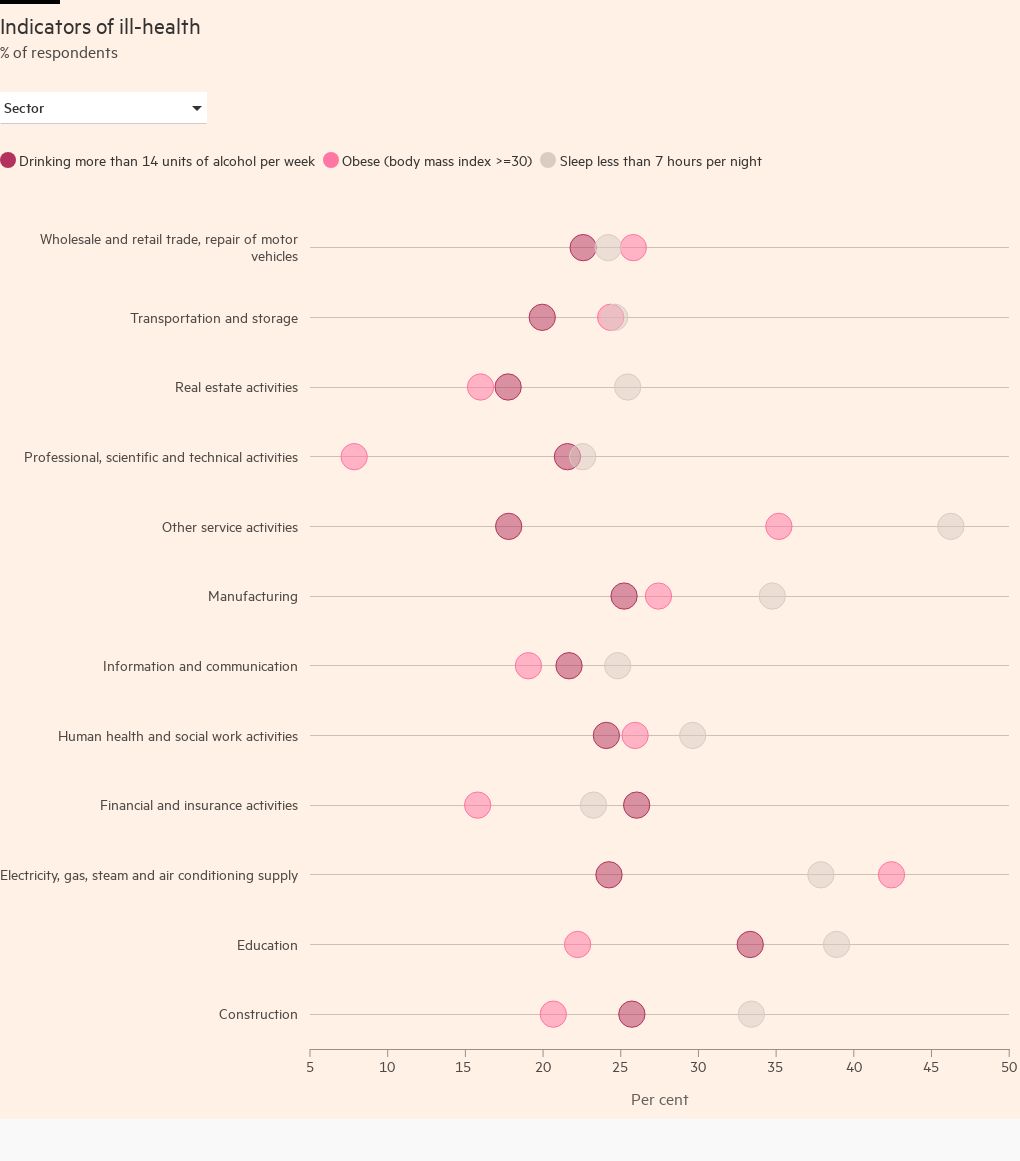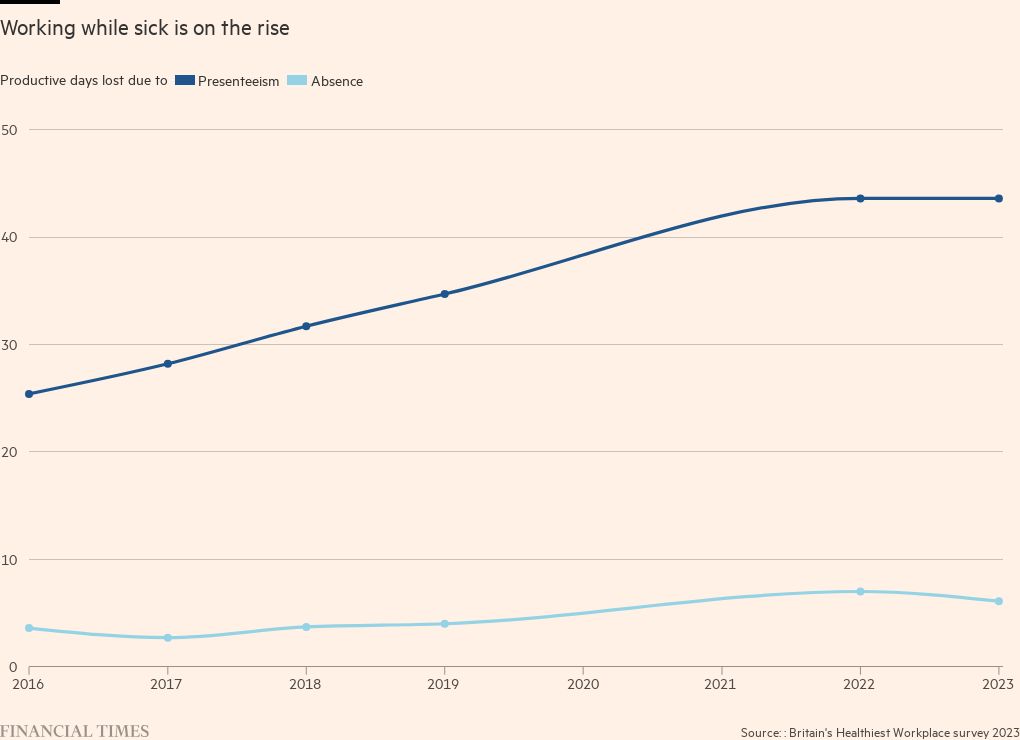UK employee health has barely improved since pandemic

Roula Khalaf, Editor of the FT, selects her favourite stories in this weekly newsletter.
UK employers lost the equivalent of 50 days of work per employee last year because of poor physical and mental health — only slightly down on peak levels in 2022 at the tail-end of the Covid-19 pandemic, according to the FT-Vitality Britain’s Healthiest Workplace survey.
Among 4,787 employees at 59 organisations polled in the year to October 2023, on average 43.6 days of work were lost due to “presenteeism” — unproductive time in the workplace. That was in addition to 6.1 days of sickness absence. Together, the amount of lost work was a 2 per cent improvement on the previous year.
The survey also indicated continued high levels of obesity, excessive drinking, and lack of sleep, even though most indicators of ill health showed a slight improvement on 2022.
The data — provided by a self-selecting group of employers and employees — was used to identify the UK’s healthiest workforces. The three winners were Arqiva, the telecommunications company, among employers with more than 1,000 staff; the UK subsidiary of Novo Nordisk, the Danish pharmaceutical company, among those with over 250 staff; and Strativ Group, a recruitment agency, among small organisations.
The survey and associated awards are funded by Vitality, in a partnership with Aon, Rand Europe, Cambridge university and the Financial Times, which helped oversee the survey. This year, the research showed important differences in wellbeing and productivity linked to income, gender, age, seniority, and work location.
Ella West, wellbeing lead at Arqiva, which uses the data to track employee wellbeing and has been developing programmes for staff over the past decade, said: “We started with a physical and mental wellbeing focus, but now recognise the need to support the whole person — including professional, social and financial wellbeing.”
A Novo Nordisk UK spokesperson said: “A sustainable business needs to embed a culture that enables their people to feel their best, both at work and in their personal lives. We use these results to ensure that our employee offering is fit for purpose.”
While employers in Britain and elsewhere spend billions of pounds each year on wellness interventions focused on individual staff, growing evidence suggests that the most significant influences are structural factors related to autonomy, sense of purpose, pay, working conditions, and supportive management.
Recent research by William Fleming at the University of Oxford even suggests that individual interventions targeting employees — such as resilience training or wellbeing apps — are of little value on their own.
Such findings are in line with longstanding arguments that improving structural factors — such as quality of management, job design, organisational culture and pay — are more important for improving workplace wellbeing.
Across the latest BHW survey, 58 per cent of employees reported being overweight, 56 per cent said they had a poor diet, 23 per cent were obese, and 37 per cent disclosed a lack of physical activity. Some 29 per cent reported poor length of sleep and 22 per cent poor sleep quality, while 10 per cent said they were depressed. Nine per cent smoked.
Productive time lost averaged 27.9 days a year for C-suite top managers and executives, rising to 51.5 days among non-managerial employees. It averaged 32.6 days for those earning more than £150,000 a year, rising to 61.6 days for those earning £20,000-30,000.
Younger employees were badly affected, with days lost as high as 60.6 among 18- to 25-year-olds, falling to 32 days for those aged 61-65. The highest share of smokers was among 26- to 30-year-olds, who also reported the greatest financial concerns. Both of the younger age ranges had the highest rates of reported depression: 18.2 per cent for 18-25s and 12.3 per cent for 26-30s, falling to 2.8 per cent for 61-65-year-olds.
Those continuing with hybrid working had lower lost productivity compared with those who always worked at an office or always worked at home. Women had more productivity losses than men.
“Line managers are fundamental,” said Cary Cooper, organisational psychology professor at Manchester university. “Wellness needs to be a strategic issue linked to metrics and accountability, with responsibility taken by a board director.”
This year’s BHW data mirrors the findings of other surveys, including the latest assessment of 918 companies conducted last year by the Chartered Institute of Personnel and Development, which found the proportion of organisations reporting a standalone wellbeing strategy has risen in recent years to 53 per cent.
However, Colin Barnes, a director at employee benefits consultancy Aon, cautioned that many such strategies were “box ticking”. He called for more emphasis on organisations to ensure a senior executive was responsible for wellness. He added that there was a greater need for employers to substantially shift spending away from the current heavy costs around staff ill-health and lost productivity, and instead towards prevention programmes.
Britain’s Healthiest Workplace — the winners
Large organisations (1,000+ employees)
1st Arqiva
2nd Nomura International
3rd Experian
Mid-sized organisations (250-999 employees)
1st Novo Nordisk
2nd Program Planning Professionals
3rd Cornerstone
Small organisations (20-249 employees)
1st Strativ Group
2nd Fourfront Group
3rd OpenCredo



Comments